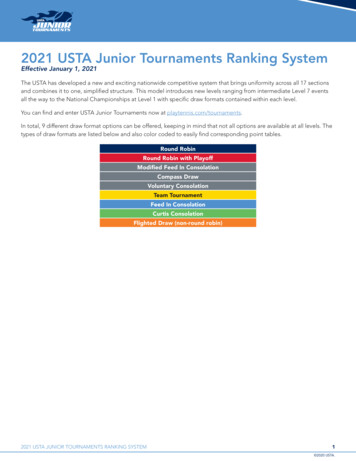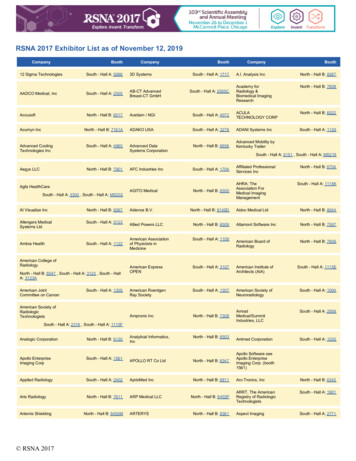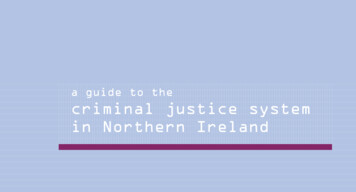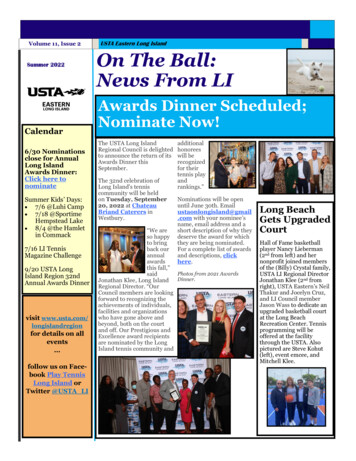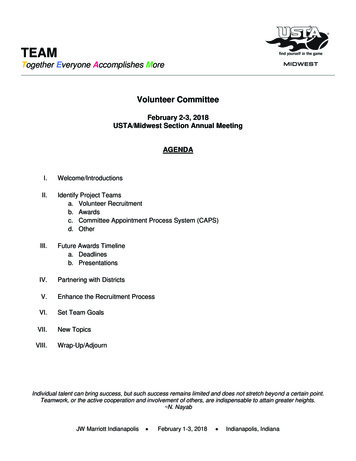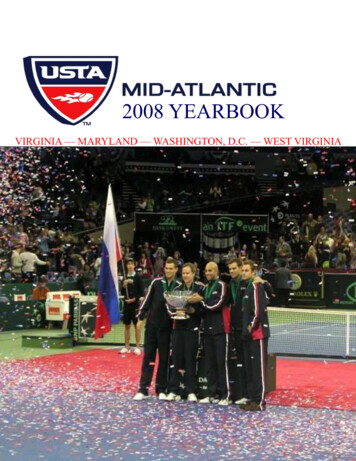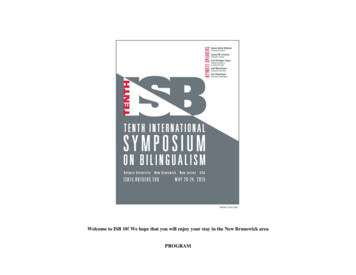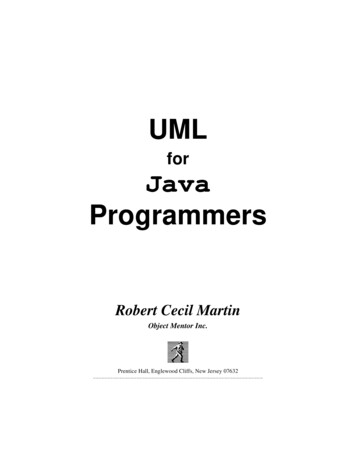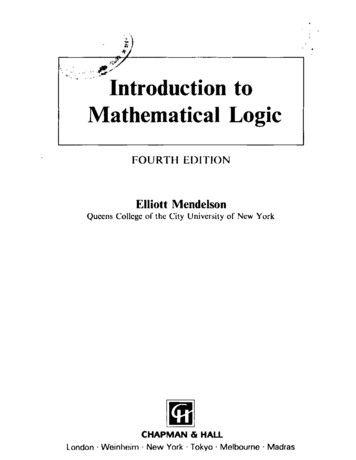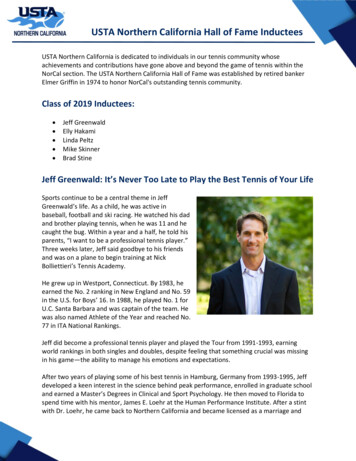
Transcription
USTA Northern California Hall of Fame InducteesUSTA Northern California is dedicated to individuals in our tennis community whoseachievements and contributions have gone above and beyond the game of tennis within theNorCal section. The USTA Northern California Hall of Fame was established by retired bankerElmer Griffin in 1974 to honor NorCal's outstanding tennis community.Class of 2019 Inductees: Jeff GreenwaldElly HakamiLinda PeltzMike SkinnerBrad StineJeff Greenwald: It’s Never Too Late to Play the Best Tennis of Your LifeSports continue to be a central theme in JeffGreenwald’s life. As a child, he was active inbaseball, football and ski racing. He watched his dadand brother playing tennis, when he was 11 and hecaught the bug. Within a year and a half, he told hisparents, “I want to be a professional tennis player.”Three weeks later, Jeff said goodbye to his friendsand was on a plane to begin training at NickBolliettieri’s Tennis Academy.He grew up in Westport, Connecticut. By 1983, heearned the No. 2 ranking in New England and No. 59in the U.S. for Boys’ 16. In 1988, he played No. 1 forU.C. Santa Barbara and was captain of the team. Hewas also named Athlete of the Year and reached No.77 in ITA National Rankings.Jeff did become a professional tennis player and played the Tour from 1991-1993, earningworld rankings in both singles and doubles, despite feeling that something crucial was missingin his game—the ability to manage his emotions and expectations.After two years of playing some of his best tennis in Hamburg, Germany from 1993-1995, Jeffdeveloped a keen interest in the science behind peak performance, enrolled in graduate schooland earned a Master’s Degrees in Clinical and Sport Psychology. He then moved to Florida tospend time with his mentor, James E. Loehr at the Human Performance Institute. After a stintwith Dr. Loehr, he came back to Northern California and became licensed as a marriage and
family therapist, specializing in sport psychology for athletes and their families and opened thedoors to Mental Edge International in 1998.Jeff felt it was crucial to test his new mindset and began to play numerous Open tournamentsin Northern California from 1995 to 2001. In 1997 he was named Men’s Open Player of theYear. In 2001, he became the Men’s 35 National Hardcourt Singles and Doubles Champion aswell as Men’s 35 ITF World Champion. He was ranked No. 1 in the world in Men’s 35, No. 1 inDoubles in the U.S. and selected for the USTA Italia Cup Team.In 2002, Jeff was named USPTA Men’s Senior Player of the Year and published his best-sellingaudio program, Fearless Tennis. By 2005, he became a member of the Coaches Commission,focusing on ways to improve junior tennis. Jeff served as a sport psychology consultant forUSTA from 2005 to 2010, for high performance coaches and players development in KeyBiscayne, Florida. In 2007, he published The Best Tennis of Your Life, the third best-sellingtennis psychology book.Jeff felt he became a vastly different player and the wins continued. Jeff became the 40National Hard Court Singles Champion in 2009, and then again seven years later in 2016 and2017, now more than a decade past the age division. He’s won two ITF World Championships,six Gold Balls, two Silver Balls, and four Bonze Balls so far. He has also received a 20 Years ofService accommodation from the USPTA.In addition to his best-selling book, Jeff has recently produced a popular online video coursecalled Fearless Tennis, which grew from his best-selling audio book. For the past two decades,Jeff has influenced thousands of athletes and professionals experience breakthroughs on andoff the court. He continues to speak and consult with the USTA and work with highly rankedplayers worldwide.Elly Hakami: Performing in the Big MomentsElly Hakami began playing tennis when she was sixyears old. Her work ethic, combined with her sheerenjoyment of tennis and her father Ray’s coaching,led to her success as a youngster. Elly spent vastamounts of time training on neighborhood courts inTiburon. In 1984, at 13 years old, Elly’s hard workbegan to pay off when she received the CaliforniaWomen’s Player of the Year and California JuniorPlayer of the Year. By 1985, Elly was ranked No. 3 inthe U.S. in the Girls’ 16.Elly’s on court success helped foster her reputationas a mentally tough player. She continued to earn
accolades when in 1986, she was awarded California Junior Player of the Year again. That year,she won the USTA National Hardcourt Championships in the Girls’ 18, was ranked No. 1 in theU.S. Girls’ 18, and won the Junior US Open. Winning the National Hardcourts earned her a WildCard into the U.S. Open main draw, where she won two rounds.The year 1987 also proved to be a stellar year for the young Hakami. Elly beat Mary JoeFernandez in the second round of the Virginia Slims tournament in Los Angeles, CA. She alsoplayed against Gabriela Sabatini at the US Open. Elly went on to play in the Aptos ChallengerSeries, where she beat Melissa Gurney in the Finals to claim her first pro singles title.Later in 1987, Elly played Martina Navratilova in the quarterfinals of the Manhattan Beachtournament. Unfortunately, Elly was caught in traffic on the way to the tournament, but cameout unflustered. Despite losing to Navratilova, Elly played a strong match, earning praise fromNavratilova: “She is a very good player. She seems to be very bright and she's a lot better allcourt player than I thought she would be. I thought she served well and she comes out tough.”In 1988, Elly reached her highest rankings: No. 32 in singles and No. 68 in doubles.Unfortunately, Elly suffered a back injury in 1989, keeping her off the court for a year. WhenElly returned to the court in 1990, she played Challengers to build her ranking back up. Elly wonthree Futures Circuit events and reached two finals between 1990 and 1994. Of all of thecoverage of her professional career, being included on Inside Tennis’s “Best Players for the Past25 Years,” is one of her greatest honors.By 1997, Elly started to spend more time coaching, teaching at Mt. Tam Racquet Club inLarkspur, CA. Becoming a coach has been fulfilling for Hakami, who views coaching as heropportunity to give back to her sport. Furthermore, when she is on the court coaching, Elly feelsa closeness to her father, as she shapes young players in much the same way that her fathertaught her. In 2005, Elly went on hiatus from tennis to raise her two children: Sonya (13) andPolo (16). Now that her children are older, Elly has returned to coaching at Mt. Tam RacquetClub.Having played on the professional circuit, and also working as a coach, Elly is well aware thattennis players must commit to a high level of dedication and perfectionism, as well as maintaina serious and tough mentality. As she says, “when it comes down to it, you have to forget whoyou are playing.You have to maintain your own sense of mental clarity and focus on how youperform.”
Linda Peltz: Volunteering, Giving Back, and Playing TennisVolunteering is a key word when describing LindaPeltz. And, she came by it naturally as her motherinstilled in her a love of giving back, helping others,and volunteering. Linda attended California StateUniversity in San Francisco and earned herbachelor’s and master’s degrees in Audiology andSpeech Pathology. She began her professional careerat Herrick Memorial Hospital in Berkeley, eventuallybecoming the Director of the Department. In 1977,she decided to pursue private practice and openedBerkeley Audiology Services, which she ran untilretirement in 2007.In 1977, Linda discovered a wonderful sport: TENNIS.In 1984, Linda and her husband, Robert, joinedHighlands Country Club near their home in Oakland. Linda served as chair of the TennisCommittee and then as President of the Board of Directors. They then joined the ClaremontHotel and Spa which led to Linda’s participation in USTA Adult League tennis, for which she hascaptained or co-captained a team every year. In 1992, Linda received her PTR certification andbegan teaching tennis to children through after school programs. Combining her professionalskills with her tennis skills, Linda started a tennis program at the California School for the Deaf.Between 1994 and 2000, Linda ran the Bank of the West Shootout for USTA NorCal and IMGwhere funds were raised for tennis programs. For at least four years she chaperoned the NorCalteam for the 16 Zonals in Salt Lake City, Utah, which was an experience she treasures.From 1994 to 2011, she served on the El Cerrito Tennis Improvement Association Board. Shewas first elected to the USTA NorCal Board of Directors in 1994 and completed her last term in2017. She served the Board as Parliamentarian, Secretary, and Vice President during her tenureon the Board. Linda has chaired and/or co-chaired the USTA NorCal Hall of Fame InductionCeremonies for the past 25 years and has served on virtually every committee in NorCal. Shehas been a member of a USTA National Committee for 15 years, and most notably has been avaluable member of the USTA Awards Committee. Linda is currently serving her second threeyear term as a member of the Board of Directors of the Berkeley Tennis Club.Linda’s volunteering goes beyond tennis. She has been a member of the Alta Bates SummitFoundation Board of Trustees for 20 years and served as Chairman of the Board for three years.In 2007, the Foundation presented her with its Lifetime Achievement Award.
Linda has also been recognized in USTA Northern California with its League Captain of the YearAward in 2004; the USTA NorCal League Volunteer of the Year Award in 2005 and 2017; and theBetty Cookson Lifetime Achievement Award in 2013.Mike Skinner: Giving Back Through TennisTennis became a passion early in Mike Skinner’slife. His parents encouraged him to play and hetook to it quickly. One of his early tennismemories was receiving a tennis award from JackKramer at a youth tennis clinic in Golden GatePark. Mike continues his lifelong passion fortennis as the Executive Director for Youth TennisAdvantage.While at Lowell High School (’65), Mike won theAll City High School Doubles Championship,played No. 2 singles and learned how to teachtennis from Don Prince at the Menlo Circus Club.While at Occidental College (’69) in Los Angeles,CA, Mike played No. 1 singles and taught for Don Prince during summer vacations. He met hiswife while playing the USTA Men’s 45 National Grass Court Championship in Philadelphia in1994.During the 1970s, Mike was an USPTA Teaching Professional working at the Katherine DelmarBurke School and Club in San Francisco, Paul Daly’s Swim & Racquet Club in Kentfield andseveral private courts in San Francisco and Napa.In 1974, Mike met Arthur Ashe at a tournament in Palm Springs. Ashe asked Mike to start achapter of his new national tennis program called National Junior Tennis League (NJTL). Mikeand his close friend, Lloyd Scott, were frustrated by the few tennis options low income kids hadin San Francisco. Mike and Lloyd believed tennis could be a powerful tool to help disadvantagedkids by providing fun, healthy exercise and a way to connect to the community. Lloyd organizedtheir first Board of Directors with Charlie Hoeveler, Barry MacKay, Tom Queen, Lloyd and Mike.The organization was incorporated in 1975 as the National Junior Tennis League of SanFrancisco, with Mike as the President for the first several years. It would become Youth TennisAdvantage (YTA) in 1999. Ashe helped the NJTL SF for about a decade, dedicating four newcourts in Hunters Point built for NJTL SF in 1986.NJTL SF added programs in San Francisco and Oakland in the 1980’s. A site at UC Berkeley wasadded in 2001 under Peter Wright, an NJTL Board member and Cal men’s tennis coach. NJTL SFadded academic and life skills components in the 1990s. In 1998, NJTL SF earned the National
Chapter of the Year. In 1999, NJTL SF combined with Youth Tennis Foundation. In 2014, Mikebecame the YTA Executive Director. In 2016, YTA was named USTA NorCal NJTL Chapter of theYear.In 2018 YTA celebrated its 50th anniversary. Today YTA runs free, year-round tennis, academicand life skills programs for over 300 low income kids in 5 locations.Mike credits his strong Board of Directors and the great coaches for YTA’s success and ability tokeep its focus on at-risk kids. Celebrities have helped YTA including Robin Williams, Willie Mays,Jack Kramer, and Joe Montana. YTA high school students graduate on time and go on to college,including Harvard and Princeton. “I’m proud we can give back and deeply touch these kids whodon’t have the same options most of us take for granted. Our kids stay with us for many yearsand excel. One of our former students just joined our board. The success of our YTA kids showus every day how they can succeed despite economic challenges and other significant lifeadversities. I want to build a YTA strong enough to serve far more at-risk kids for another 50years and beyond. Their success is our future.”Brad Stine: Building a Philosophy Through TennisBrad Stine presented his coach, CañadaCommunity College’s Rich Anderson, whenAnderson was inducted into the Hall of Fame.That was in 2014. Little did he know he’d beinducted in 2019.His tennis journey started at the age of 14. Bradwas an avid baseball player. He was recruited forhis All-Star team and looked forward to thecompetition. As fate would have it, he broke hishand the day before the game. He couldn’t playbaseball with his cast on, but he discovered hecould bat a tennis ball around one-handed. Thus,his love of tennis was born.Brad racked up accolades and awards throughout his tennis years. His team from Cañadaearned the state championship in 1978. He earned a tennis scholarship to Fresno State for twoyears. By 1982, he served as Assistant Coach for the Fresno State Men’s Tennis team and spenthis summers playing tennis in Europe. By 1985, Brad became the youngest head coach in thecountry. Around that time, he connected with Greg Patton, the head coach for the US NationalJunior Davis Cup Team. He joined Greg and the team as Assistant Coach and began workingwith top junior players who later became pros, including Jim Courier, Pete Sampras and MichaelChang.
By 1988, Brad continued to coach with USTA during his summers. He noted his “luck” to workwith and travel with his mentor, Tom Gullickson for 16 weeks. The Fresno team continued togrow; they were ranked in the top 25 teams in the country for three years in a row. In 1990 and1991, Brad was named Big West Coach of the Year.Brad became Jim Courier’s coach from 1991 to 1994. During this time, Courier reach No. 1 ATP,won two French Opens, two Australian Opens and participated in four Grand Slam Finals.In May 1994, Brad began coaching Andrei Medvedev, who was ranked in the top 10 ATP andwon one title. In 1995, Brad coached Jonathan Stark, who was No. 1 ATP Doubles with ByronBlack and won a singles title in Singapore, 1996. In 1997 to 2000, Brad returned to coaching JimCourier. After Courier retired, Brad coached Mardy Fish, who went from 365 to 126 in the ATPrankings. After working with Mardy, Brad coached Taylor Dent from 2002 to 2003. This wascredited as Taylor’s most successful year on tour, including winning a singles title. In 2005 to2007, Brad worked with Sebastien Grosjean, who reached Top 25 ATP ranking and thequarterfinals in the Australian Open and Wimbledon.After his storied pro coaching career, Brad directed his 360 Tennis Academy in Fresno, CA, forseveral years. In October 2014, Brad made the move to Orlando, FL, to work full time with theUSTA. But in 2017, the pros called again when he began coaching Kevin Anderson. Kevin wentfrom No. 15 to No. 5 ATP, made his first appearance at ATP finals and won two titles.Brad credits his success in coaching to mentors like Greg Patton, Rich Anderson, Tom Gullicksonand Jose Higueras. “I’ve been lucky to have amazing mentors help me develop my philosophyand coaching techniques,” Brad said. Working in vastly different environments andcircumstances, like college to pro teams, honed his philosophy—"working through hard times,facing all confrontations, navigating through them is what guides us to our great moments.”
world rankings in both singles and doubles, despite feeling that something crucial was missing in his game—the ability to manage his emotions and expectations. After two years of playing some of his best tennis in Hamburg, Germany from 1993-1995, Jeff developed a keen interest in the science behind peak performance, enrolled in graduate school
